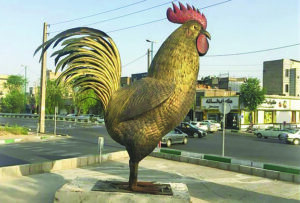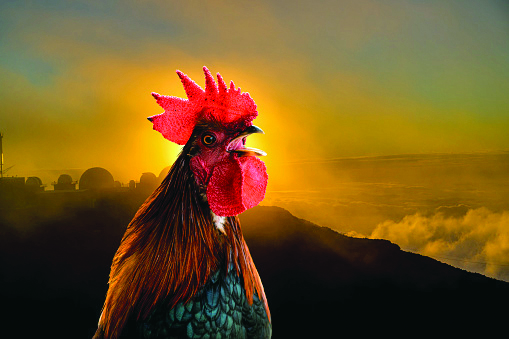 Although Parsis love eating chicken farcha, as rule we do not eat the rooster. Long before broiler chicken came to India, my family and most Parsi families, rural or urban, considered eating chicken a luxury and therefore consumed murghi only on festive occasions. Mutton was consumed through the year.
Although Parsis love eating chicken farcha, as rule we do not eat the rooster. Long before broiler chicken came to India, my family and most Parsi families, rural or urban, considered eating chicken a luxury and therefore consumed murghi only on festive occasions. Mutton was consumed through the year.
I remember accompanying my dad to the Grant Road market in Mumbai, usually a day before any festive occasion to buy chicken, and he would instruct the vendor to pull out a murghi (hen) and not a murgha (rooster). There was no refrigerator at home those days and therefore the chicken would be washed and marinated to be cooked the next day. When I’d ask him why the hen and not the rooster, he’d say that the hen’s meat was more tender than the rooster’s… and if we were lucky, we may also find an egg inside the hen! My more orthodox mother would share the religious reason.
Rooster In Zoroastrianism
In the Zoroastrian tradition, the dog and the rooster hold equal positions of importance. Dogs (especially those with two spots over the eyes) and roosters (especially those with white feathers) are believed to be co-workers of Sarosh Yazata – the Guardian Angle of souls of the living and the souls of the dead. It is also believed that when Bahram Yazata is invoked by the righteous, this Yazata carries with him a rooster to bring victory to the devotee.
In ancient times, almost every family had a dog and a rooster at home – the dog to guard the house at night and the rooster to awaken the family at the crack of dawn. Both were treated with respect, affection and treated as family. On the passing of either, the family would wrap them in an old sudreh before the final disposal.
The rooster is considered a warrior against the forces of darkness, associated with the absence of light and therefore, negative or evil. The Bundahishn, the Zoroastrian book of Genesis or creation, avers that Ahura Mazda created the rooster to battle demonic forces. Long before alarm clocks, the rooster helped human beings fight the demon of sloth and laziness by waking up the entire household at dawn start with household and worldly duties.
 The Legend Of Zohak
The Legend Of Zohak
It is believed that the legendary spiritual King – Shah Faridoon has enchained Zohak or Azi Dahak, the living embodiment and epitome of evil, to the great spiritual mountain – Damavand, in Iran. As per legend, every night when darkness grows, the forces of evil gain strength and the chains weaken. However, at the crack of dawn when the rooster crows and welcomes sunlight, the chains are again secured and the evil one is rendered powerless. This is an important truth in Nature, wrapped in an easy-to-understand legend. Neither darkness nor evil has its own existence. Darkness is merely the absence of light and evil the absence of good. The only way to negate darkness is with light and the only way to dispel evil is through good thoughts, words and deeds.
The rooster crowing at dawn reminds us that darkness is non-existent. Only light is real and just the way sunlight dispels darkness, the light of knowledge can dispel the demon of ignorance, the light of philanthropy can destroy the demon of poverty and the light of our good thoughts, words and deeds can make this world a better place to live in.
Rooster Saves the Princess
There is also the legend of Banu Pars (Lady of Pars or Persia) – one of the daughters of the last Zoroastrian Shahensha of Iran, Yezdagird Sheriyar. When she was fleeing from the Arabs in the Yazd desert and had fallen asleep after exhaustion, it was a rooster that woke her up and saved her from getting captured by the Arabs. Zoroastrians of Yazd consider the Shrine of Peer-e-Banu holy and associate the rooster as a protector at this holy shrine.
Symbol Of The Rooster
Many cultures look to animals and birds in the natural world as symbolic of progress and prosperity. The rooster is the only bird that is included with eleven other zodiac animals. As the tenth in chronology, the rooster is associated with yang (masculinity) and energy.
In China, the rooster is considered an auspicious symbol of good luck, vitality, and safety. Chinese homes keep an image of a rooster at the entrance in the belief that it keeps away forces of negativity and ushers in positive energy.
In Zoroastrian homes, it is common to decorate the entrance or threshold at home with the rooster design in chalk (rangoli), especially on Ardibehesht, Adar, Sarosh and Bahram Roj. One can also find colourful rooster imagery in many ancient Chinese art motifs including on ancient Chinese silk Garas worn by Parsi women.
The rooster is also believed to be connected to the legendary phoenix, which governs the direction of the fire element and the south direction, which ushers prosperity. Both – Chinese and Zoroastrians consider South and the rooster as auspicious. It is not unusual to see a rooster image on a weather vane propped on the top of a roof. The Chinese believe that the rooster in the weather vane improves the chi or qi (life force or vital energy) at the place where it is installed. The Poona Kadmi & Shahenshahi Dar-e-Meher (Camp area) had such a weather vane installed and locals started calling it (and to this date) as the Komda Agyari or fire temple with the rooster.
At Bombay’s Britannia & company (famous for Berry Pulao), the proprietor (Late) Bohman Kohinoor used to sit at the cash counter with his pet rooster. When the rooster died, he put the rooster’s picture above the cash counter. He believed the rooster brought his restaurant fame and prosperity. Those working at Ballard Pier used to call Britannia & company as the Rooster Restaurant!
Rooster In Hindu Mythology
In Hindu mythology, the rooster is depicted as the vahana (vehicle) of Goddess Aditi or Bahuchara Mata, the mother of all Gods and the creator and guardian of all life. The universe was said to be inside her womb. She wields a trishool (trident) in one hand and a sword in the other and crosses the boundless sky perched on a fiery red rooster. Another Hindu Divinity, Lord Murugan, or Subrahmanya or Kartikeya – the God of war and the son of Lord Shiva and Goddess Parvati, mostly worshipped in South India, holds a flag with the image of a rooster, symbolizing the dawn of wisdom and victory of knowledge over ignorance.
- Celebrating Motherhood - 11 May2024
- Parsi Thy Name Is Humour! - 4 May2024
- The Poison of Pessimism - 27 April2024
